Business Strategy Report: Volkswagen's Strategic Analysis and Planning
VerifiedAdded on 2020/07/22
|13
|3667
|48
Report
AI Summary
This report offers a comprehensive analysis of Volkswagen's business strategy. It begins with an introduction to strategic planning, exploring the role of business missions, goals, and the effectiveness of various strategic planning techniques. The core of the report involves a detailed organizational audit using SWOT analysis and an environmental audit utilizing PESTLE analysis. Stakeholder analysis is also examined to understand their significance in strategy formulation. The report proposes a new strategy for Volkswagen, considering both developed and developing markets, with an emphasis on organic growth in Asian markets. The evaluation of alternative strategies, including market entry, product development, and retrenchment, is presented, along with justification for the selected strategy. The report concludes by discussing the responsibilities of personnel involved in strategy execution, resource requirements, and the role of SMART targets in implementation. References are also included.
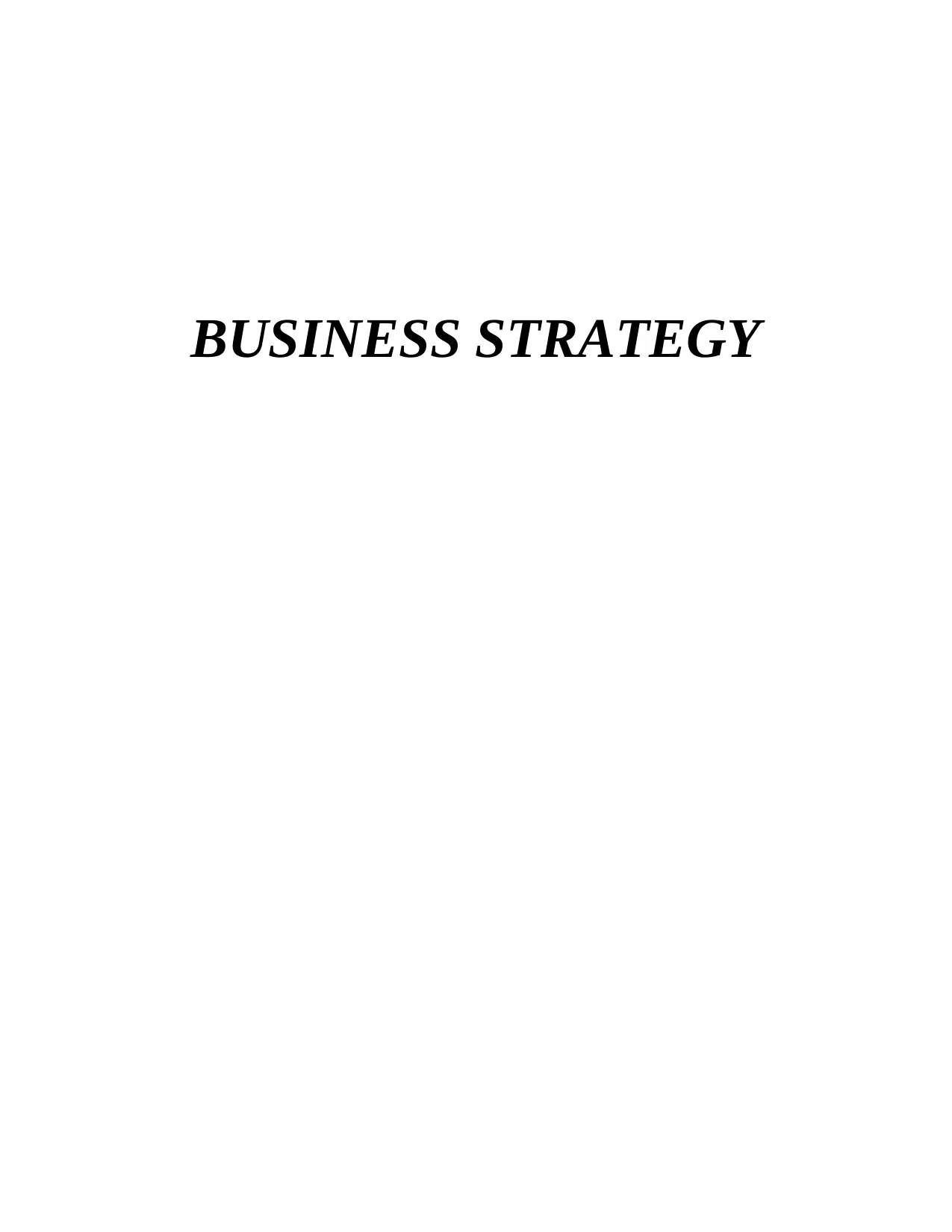
BUSINESS STRATEGY
Paraphrase This Document
Need a fresh take? Get an instant paraphrase of this document with our AI Paraphraser
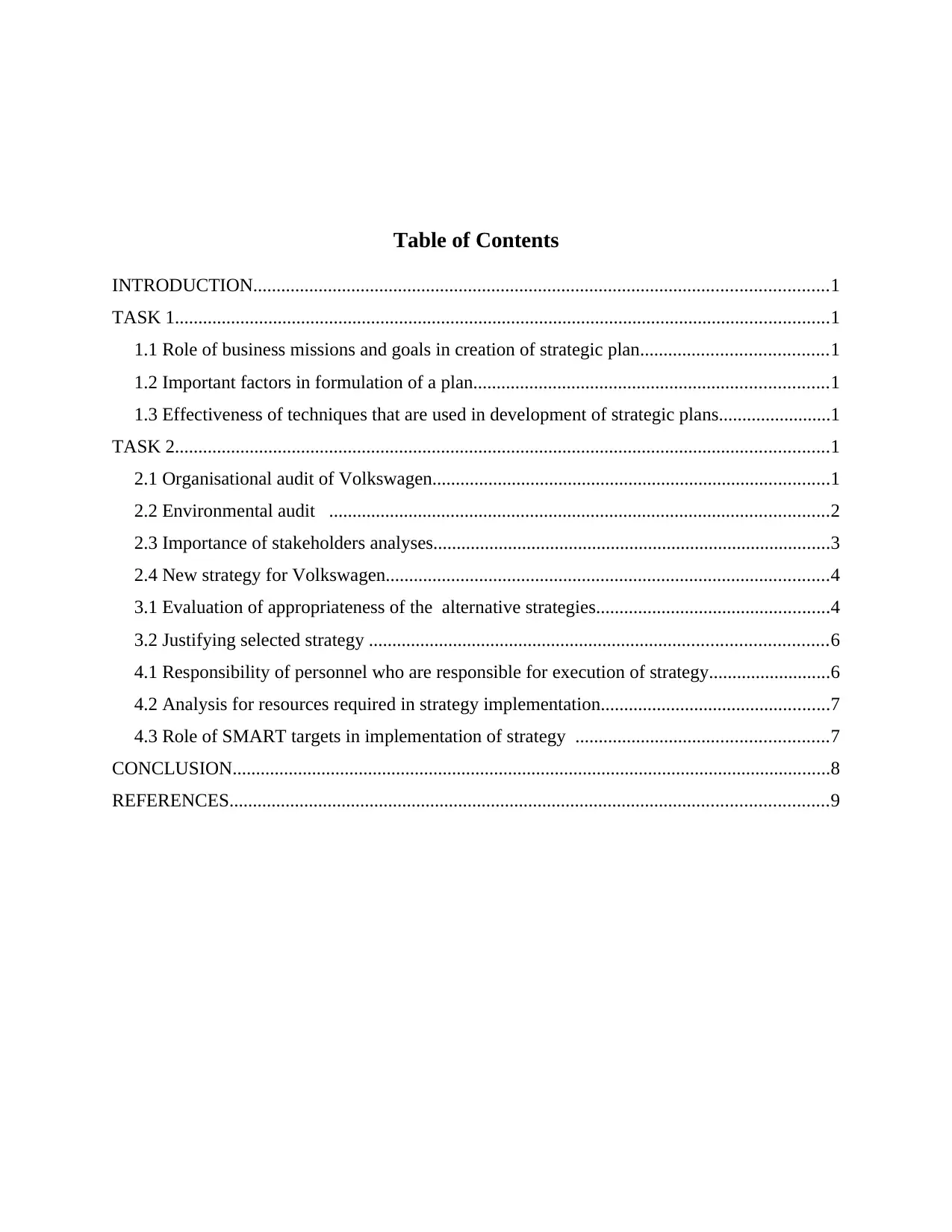
Table of Contents
INTRODUCTION...........................................................................................................................1
TASK 1............................................................................................................................................1
1.1 Role of business missions and goals in creation of strategic plan........................................1
1.2 Important factors in formulation of a plan............................................................................1
1.3 Effectiveness of techniques that are used in development of strategic plans........................1
TASK 2............................................................................................................................................1
2.1 Organisational audit of Volkswagen.....................................................................................1
2.2 Environmental audit ...........................................................................................................2
2.3 Importance of stakeholders analyses.....................................................................................3
2.4 New strategy for Volkswagen...............................................................................................4
3.1 Evaluation of appropriateness of the alternative strategies..................................................4
3.2 Justifying selected strategy ..................................................................................................6
4.1 Responsibility of personnel who are responsible for execution of strategy..........................6
4.2 Analysis for resources required in strategy implementation.................................................7
4.3 Role of SMART targets in implementation of strategy ......................................................7
CONCLUSION................................................................................................................................8
REFERENCES................................................................................................................................9
INTRODUCTION...........................................................................................................................1
TASK 1............................................................................................................................................1
1.1 Role of business missions and goals in creation of strategic plan........................................1
1.2 Important factors in formulation of a plan............................................................................1
1.3 Effectiveness of techniques that are used in development of strategic plans........................1
TASK 2............................................................................................................................................1
2.1 Organisational audit of Volkswagen.....................................................................................1
2.2 Environmental audit ...........................................................................................................2
2.3 Importance of stakeholders analyses.....................................................................................3
2.4 New strategy for Volkswagen...............................................................................................4
3.1 Evaluation of appropriateness of the alternative strategies..................................................4
3.2 Justifying selected strategy ..................................................................................................6
4.1 Responsibility of personnel who are responsible for execution of strategy..........................6
4.2 Analysis for resources required in strategy implementation.................................................7
4.3 Role of SMART targets in implementation of strategy ......................................................7
CONCLUSION................................................................................................................................8
REFERENCES................................................................................................................................9
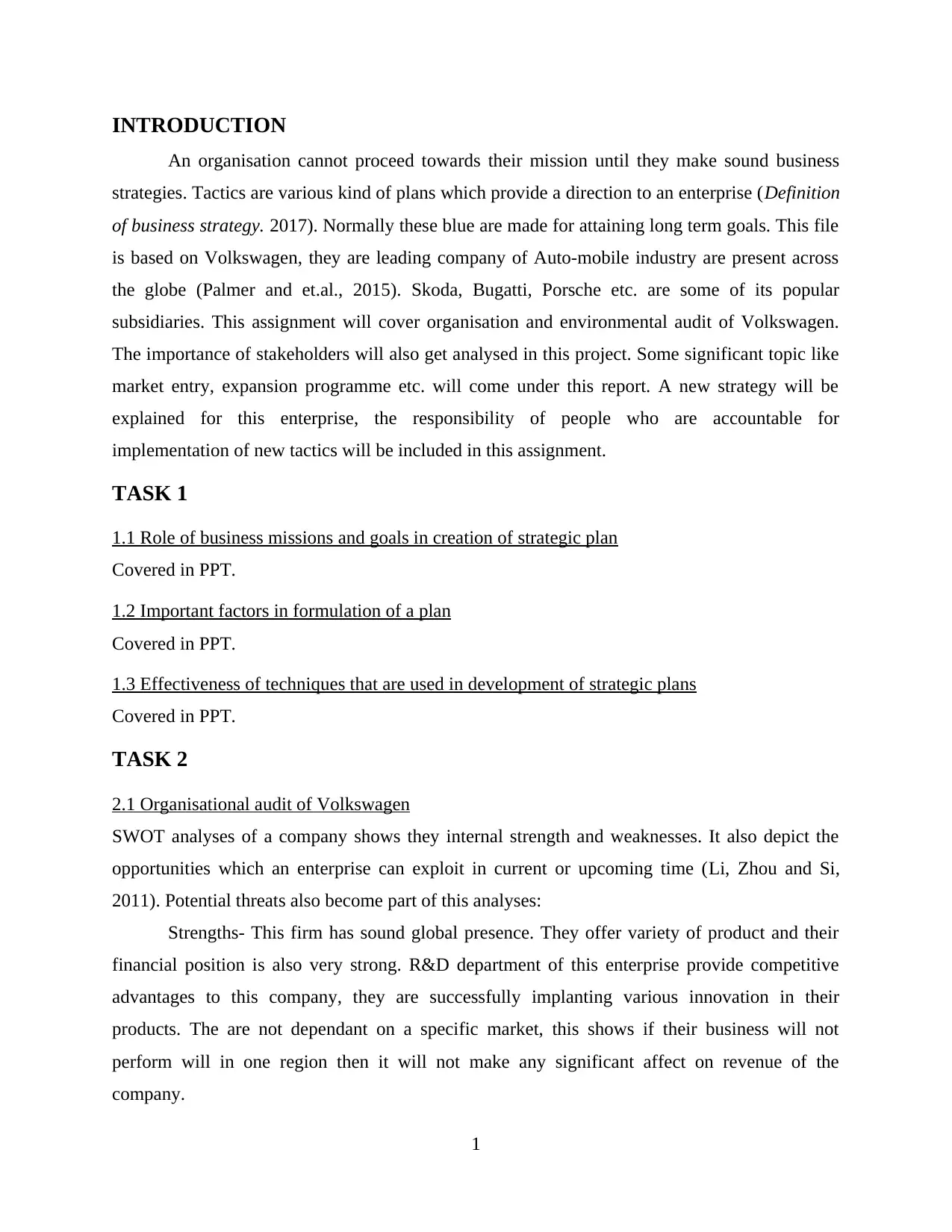
INTRODUCTION
An organisation cannot proceed towards their mission until they make sound business
strategies. Tactics are various kind of plans which provide a direction to an enterprise (Definition
of business strategy. 2017). Normally these blue are made for attaining long term goals. This file
is based on Volkswagen, they are leading company of Auto-mobile industry are present across
the globe (Palmer and et.al., 2015). Skoda, Bugatti, Porsche etc. are some of its popular
subsidiaries. This assignment will cover organisation and environmental audit of Volkswagen.
The importance of stakeholders will also get analysed in this project. Some significant topic like
market entry, expansion programme etc. will come under this report. A new strategy will be
explained for this enterprise, the responsibility of people who are accountable for
implementation of new tactics will be included in this assignment.
TASK 1
1.1 Role of business missions and goals in creation of strategic plan
Covered in PPT.
1.2 Important factors in formulation of a plan
Covered in PPT.
1.3 Effectiveness of techniques that are used in development of strategic plans
Covered in PPT.
TASK 2
2.1 Organisational audit of Volkswagen
SWOT analyses of a company shows they internal strength and weaknesses. It also depict the
opportunities which an enterprise can exploit in current or upcoming time (Li, Zhou and Si,
2011). Potential threats also become part of this analyses:
Strengths- This firm has sound global presence. They offer variety of product and their
financial position is also very strong. R&D department of this enterprise provide competitive
advantages to this company, they are successfully implanting various innovation in their
products. The are not dependant on a specific market, this shows if their business will not
perform will in one region then it will not make any significant affect on revenue of the
company.
1
An organisation cannot proceed towards their mission until they make sound business
strategies. Tactics are various kind of plans which provide a direction to an enterprise (Definition
of business strategy. 2017). Normally these blue are made for attaining long term goals. This file
is based on Volkswagen, they are leading company of Auto-mobile industry are present across
the globe (Palmer and et.al., 2015). Skoda, Bugatti, Porsche etc. are some of its popular
subsidiaries. This assignment will cover organisation and environmental audit of Volkswagen.
The importance of stakeholders will also get analysed in this project. Some significant topic like
market entry, expansion programme etc. will come under this report. A new strategy will be
explained for this enterprise, the responsibility of people who are accountable for
implementation of new tactics will be included in this assignment.
TASK 1
1.1 Role of business missions and goals in creation of strategic plan
Covered in PPT.
1.2 Important factors in formulation of a plan
Covered in PPT.
1.3 Effectiveness of techniques that are used in development of strategic plans
Covered in PPT.
TASK 2
2.1 Organisational audit of Volkswagen
SWOT analyses of a company shows they internal strength and weaknesses. It also depict the
opportunities which an enterprise can exploit in current or upcoming time (Li, Zhou and Si,
2011). Potential threats also become part of this analyses:
Strengths- This firm has sound global presence. They offer variety of product and their
financial position is also very strong. R&D department of this enterprise provide competitive
advantages to this company, they are successfully implanting various innovation in their
products. The are not dependant on a specific market, this shows if their business will not
perform will in one region then it will not make any significant affect on revenue of the
company.
1
⊘ This is a preview!⊘
Do you want full access?
Subscribe today to unlock all pages.

Trusted by 1+ million students worldwide
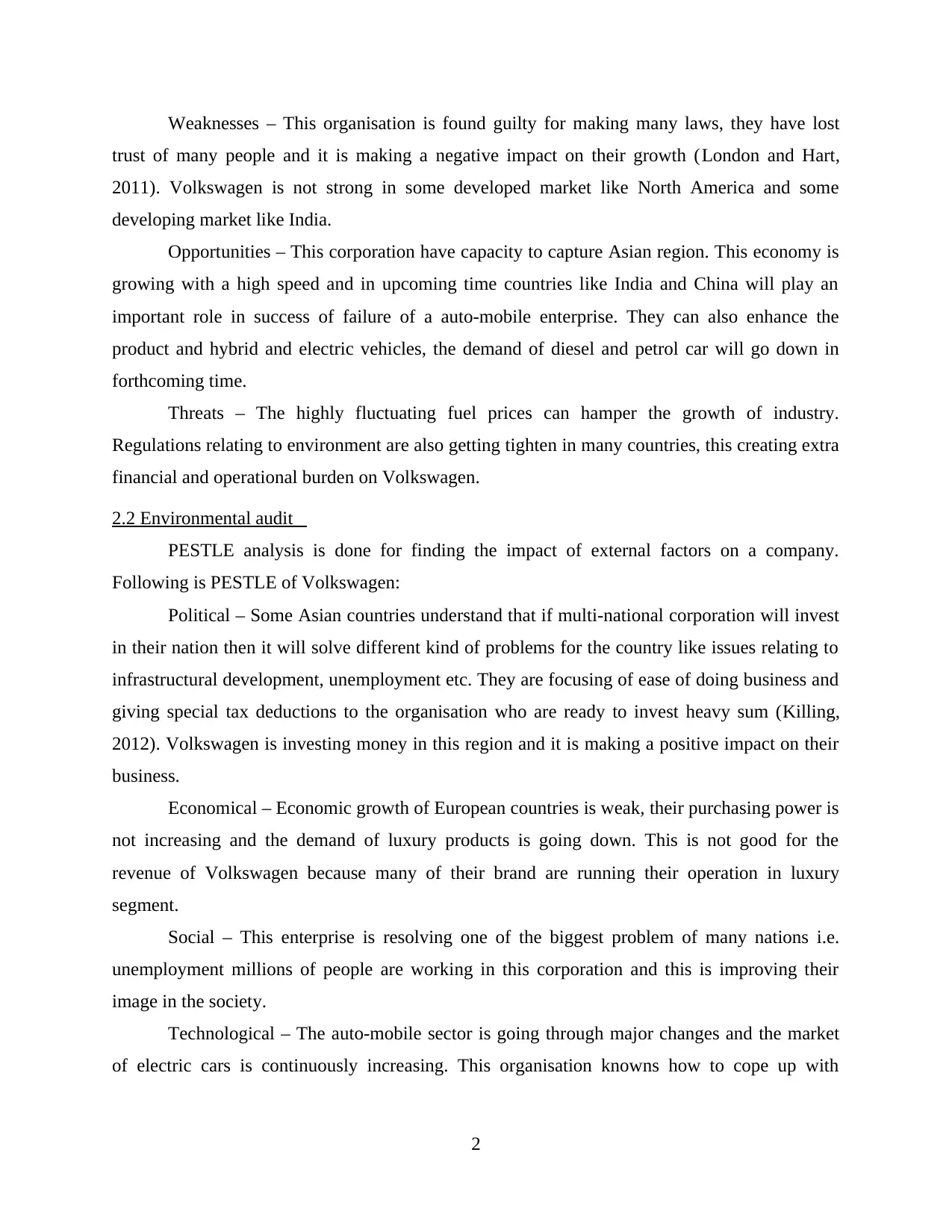
Weaknesses – This organisation is found guilty for making many laws, they have lost
trust of many people and it is making a negative impact on their growth (London and Hart,
2011). Volkswagen is not strong in some developed market like North America and some
developing market like India.
Opportunities – This corporation have capacity to capture Asian region. This economy is
growing with a high speed and in upcoming time countries like India and China will play an
important role in success of failure of a auto-mobile enterprise. They can also enhance the
product and hybrid and electric vehicles, the demand of diesel and petrol car will go down in
forthcoming time.
Threats – The highly fluctuating fuel prices can hamper the growth of industry.
Regulations relating to environment are also getting tighten in many countries, this creating extra
financial and operational burden on Volkswagen.
2.2 Environmental audit
PESTLE analysis is done for finding the impact of external factors on a company.
Following is PESTLE of Volkswagen:
Political – Some Asian countries understand that if multi-national corporation will invest
in their nation then it will solve different kind of problems for the country like issues relating to
infrastructural development, unemployment etc. They are focusing of ease of doing business and
giving special tax deductions to the organisation who are ready to invest heavy sum (Killing,
2012). Volkswagen is investing money in this region and it is making a positive impact on their
business.
Economical – Economic growth of European countries is weak, their purchasing power is
not increasing and the demand of luxury products is going down. This is not good for the
revenue of Volkswagen because many of their brand are running their operation in luxury
segment.
Social – This enterprise is resolving one of the biggest problem of many nations i.e.
unemployment millions of people are working in this corporation and this is improving their
image in the society.
Technological – The auto-mobile sector is going through major changes and the market
of electric cars is continuously increasing. This organisation knowns how to cope up with
2
trust of many people and it is making a negative impact on their growth (London and Hart,
2011). Volkswagen is not strong in some developed market like North America and some
developing market like India.
Opportunities – This corporation have capacity to capture Asian region. This economy is
growing with a high speed and in upcoming time countries like India and China will play an
important role in success of failure of a auto-mobile enterprise. They can also enhance the
product and hybrid and electric vehicles, the demand of diesel and petrol car will go down in
forthcoming time.
Threats – The highly fluctuating fuel prices can hamper the growth of industry.
Regulations relating to environment are also getting tighten in many countries, this creating extra
financial and operational burden on Volkswagen.
2.2 Environmental audit
PESTLE analysis is done for finding the impact of external factors on a company.
Following is PESTLE of Volkswagen:
Political – Some Asian countries understand that if multi-national corporation will invest
in their nation then it will solve different kind of problems for the country like issues relating to
infrastructural development, unemployment etc. They are focusing of ease of doing business and
giving special tax deductions to the organisation who are ready to invest heavy sum (Killing,
2012). Volkswagen is investing money in this region and it is making a positive impact on their
business.
Economical – Economic growth of European countries is weak, their purchasing power is
not increasing and the demand of luxury products is going down. This is not good for the
revenue of Volkswagen because many of their brand are running their operation in luxury
segment.
Social – This enterprise is resolving one of the biggest problem of many nations i.e.
unemployment millions of people are working in this corporation and this is improving their
image in the society.
Technological – The auto-mobile sector is going through major changes and the market
of electric cars is continuously increasing. This organisation knowns how to cope up with
2
Paraphrase This Document
Need a fresh take? Get an instant paraphrase of this document with our AI Paraphraser
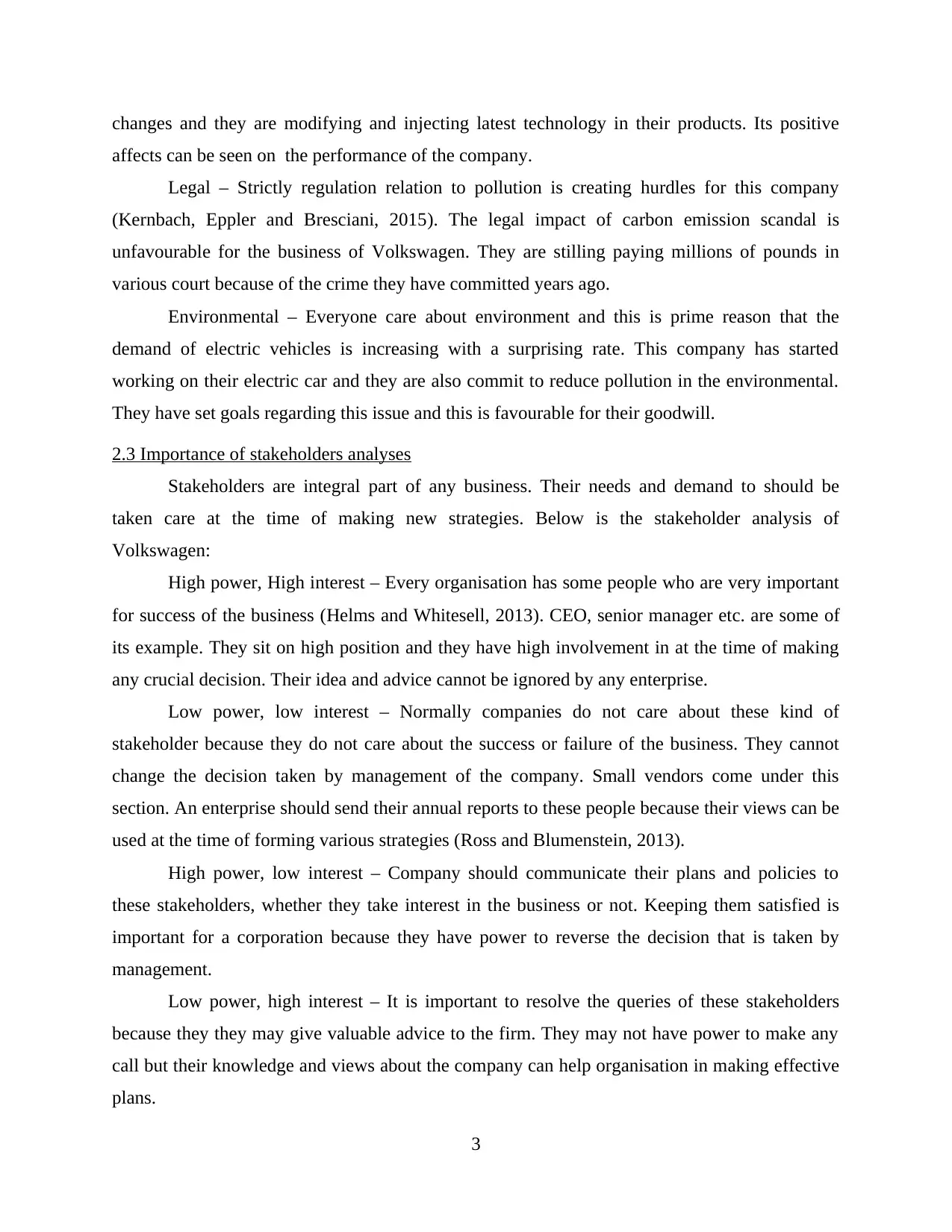
changes and they are modifying and injecting latest technology in their products. Its positive
affects can be seen on the performance of the company.
Legal – Strictly regulation relation to pollution is creating hurdles for this company
(Kernbach, Eppler and Bresciani, 2015). The legal impact of carbon emission scandal is
unfavourable for the business of Volkswagen. They are stilling paying millions of pounds in
various court because of the crime they have committed years ago.
Environmental – Everyone care about environment and this is prime reason that the
demand of electric vehicles is increasing with a surprising rate. This company has started
working on their electric car and they are also commit to reduce pollution in the environmental.
They have set goals regarding this issue and this is favourable for their goodwill.
2.3 Importance of stakeholders analyses
Stakeholders are integral part of any business. Their needs and demand to should be
taken care at the time of making new strategies. Below is the stakeholder analysis of
Volkswagen:
High power, High interest – Every organisation has some people who are very important
for success of the business (Helms and Whitesell, 2013). CEO, senior manager etc. are some of
its example. They sit on high position and they have high involvement in at the time of making
any crucial decision. Their idea and advice cannot be ignored by any enterprise.
Low power, low interest – Normally companies do not care about these kind of
stakeholder because they do not care about the success or failure of the business. They cannot
change the decision taken by management of the company. Small vendors come under this
section. An enterprise should send their annual reports to these people because their views can be
used at the time of forming various strategies (Ross and Blumenstein, 2013).
High power, low interest – Company should communicate their plans and policies to
these stakeholders, whether they take interest in the business or not. Keeping them satisfied is
important for a corporation because they have power to reverse the decision that is taken by
management.
Low power, high interest – It is important to resolve the queries of these stakeholders
because they they may give valuable advice to the firm. They may not have power to make any
call but their knowledge and views about the company can help organisation in making effective
plans.
3
affects can be seen on the performance of the company.
Legal – Strictly regulation relation to pollution is creating hurdles for this company
(Kernbach, Eppler and Bresciani, 2015). The legal impact of carbon emission scandal is
unfavourable for the business of Volkswagen. They are stilling paying millions of pounds in
various court because of the crime they have committed years ago.
Environmental – Everyone care about environment and this is prime reason that the
demand of electric vehicles is increasing with a surprising rate. This company has started
working on their electric car and they are also commit to reduce pollution in the environmental.
They have set goals regarding this issue and this is favourable for their goodwill.
2.3 Importance of stakeholders analyses
Stakeholders are integral part of any business. Their needs and demand to should be
taken care at the time of making new strategies. Below is the stakeholder analysis of
Volkswagen:
High power, High interest – Every organisation has some people who are very important
for success of the business (Helms and Whitesell, 2013). CEO, senior manager etc. are some of
its example. They sit on high position and they have high involvement in at the time of making
any crucial decision. Their idea and advice cannot be ignored by any enterprise.
Low power, low interest – Normally companies do not care about these kind of
stakeholder because they do not care about the success or failure of the business. They cannot
change the decision taken by management of the company. Small vendors come under this
section. An enterprise should send their annual reports to these people because their views can be
used at the time of forming various strategies (Ross and Blumenstein, 2013).
High power, low interest – Company should communicate their plans and policies to
these stakeholders, whether they take interest in the business or not. Keeping them satisfied is
important for a corporation because they have power to reverse the decision that is taken by
management.
Low power, high interest – It is important to resolve the queries of these stakeholders
because they they may give valuable advice to the firm. They may not have power to make any
call but their knowledge and views about the company can help organisation in making effective
plans.
3
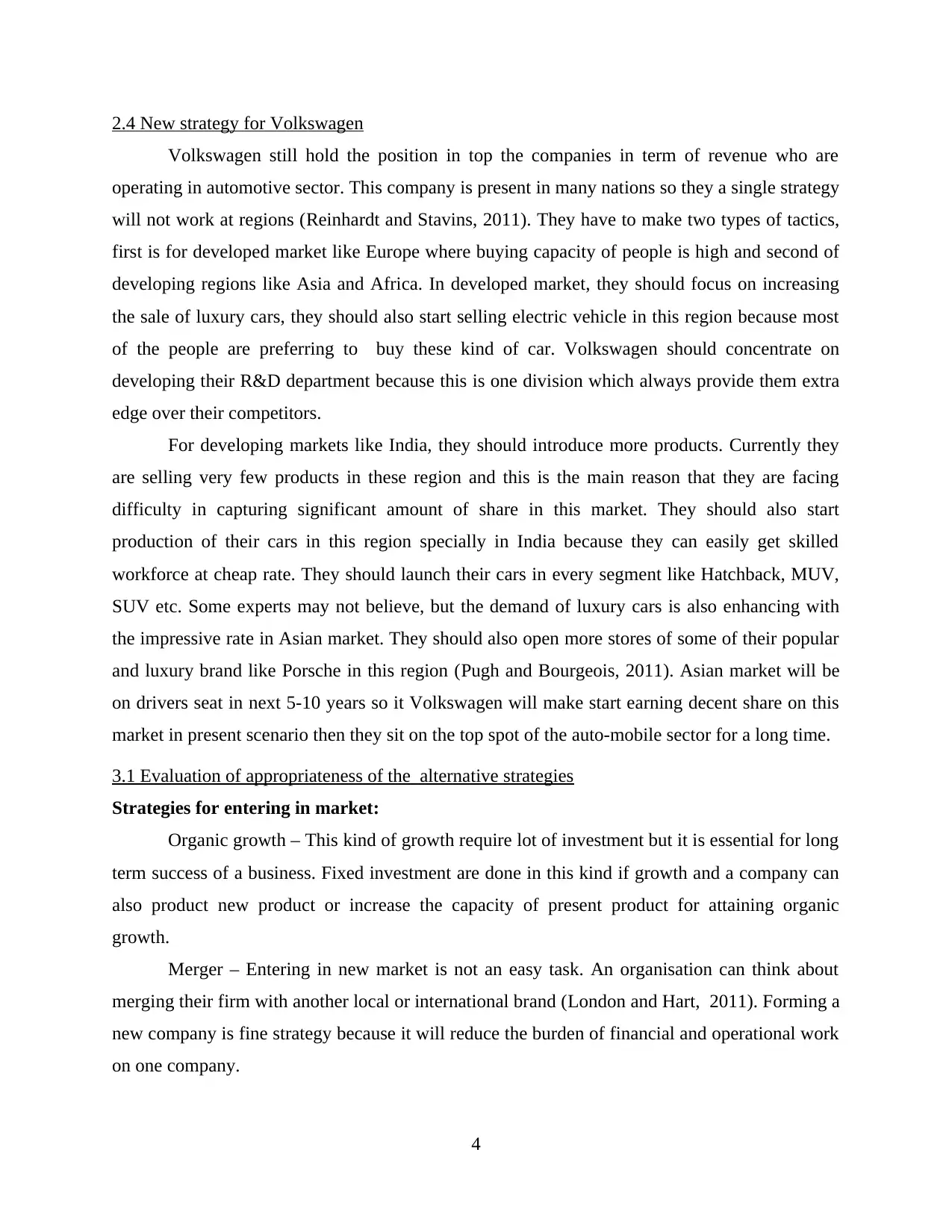
2.4 New strategy for Volkswagen
Volkswagen still hold the position in top the companies in term of revenue who are
operating in automotive sector. This company is present in many nations so they a single strategy
will not work at regions (Reinhardt and Stavins, 2011). They have to make two types of tactics,
first is for developed market like Europe where buying capacity of people is high and second of
developing regions like Asia and Africa. In developed market, they should focus on increasing
the sale of luxury cars, they should also start selling electric vehicle in this region because most
of the people are preferring to buy these kind of car. Volkswagen should concentrate on
developing their R&D department because this is one division which always provide them extra
edge over their competitors.
For developing markets like India, they should introduce more products. Currently they
are selling very few products in these region and this is the main reason that they are facing
difficulty in capturing significant amount of share in this market. They should also start
production of their cars in this region specially in India because they can easily get skilled
workforce at cheap rate. They should launch their cars in every segment like Hatchback, MUV,
SUV etc. Some experts may not believe, but the demand of luxury cars is also enhancing with
the impressive rate in Asian market. They should also open more stores of some of their popular
and luxury brand like Porsche in this region (Pugh and Bourgeois, 2011). Asian market will be
on drivers seat in next 5-10 years so it Volkswagen will make start earning decent share on this
market in present scenario then they sit on the top spot of the auto-mobile sector for a long time.
3.1 Evaluation of appropriateness of the alternative strategies
Strategies for entering in market:
Organic growth – This kind of growth require lot of investment but it is essential for long
term success of a business. Fixed investment are done in this kind if growth and a company can
also product new product or increase the capacity of present product for attaining organic
growth.
Merger – Entering in new market is not an easy task. An organisation can think about
merging their firm with another local or international brand (London and Hart, 2011). Forming a
new company is fine strategy because it will reduce the burden of financial and operational work
on one company.
4
Volkswagen still hold the position in top the companies in term of revenue who are
operating in automotive sector. This company is present in many nations so they a single strategy
will not work at regions (Reinhardt and Stavins, 2011). They have to make two types of tactics,
first is for developed market like Europe where buying capacity of people is high and second of
developing regions like Asia and Africa. In developed market, they should focus on increasing
the sale of luxury cars, they should also start selling electric vehicle in this region because most
of the people are preferring to buy these kind of car. Volkswagen should concentrate on
developing their R&D department because this is one division which always provide them extra
edge over their competitors.
For developing markets like India, they should introduce more products. Currently they
are selling very few products in these region and this is the main reason that they are facing
difficulty in capturing significant amount of share in this market. They should also start
production of their cars in this region specially in India because they can easily get skilled
workforce at cheap rate. They should launch their cars in every segment like Hatchback, MUV,
SUV etc. Some experts may not believe, but the demand of luxury cars is also enhancing with
the impressive rate in Asian market. They should also open more stores of some of their popular
and luxury brand like Porsche in this region (Pugh and Bourgeois, 2011). Asian market will be
on drivers seat in next 5-10 years so it Volkswagen will make start earning decent share on this
market in present scenario then they sit on the top spot of the auto-mobile sector for a long time.
3.1 Evaluation of appropriateness of the alternative strategies
Strategies for entering in market:
Organic growth – This kind of growth require lot of investment but it is essential for long
term success of a business. Fixed investment are done in this kind if growth and a company can
also product new product or increase the capacity of present product for attaining organic
growth.
Merger – Entering in new market is not an easy task. An organisation can think about
merging their firm with another local or international brand (London and Hart, 2011). Forming a
new company is fine strategy because it will reduce the burden of financial and operational work
on one company.
4
⊘ This is a preview!⊘
Do you want full access?
Subscribe today to unlock all pages.

Trusted by 1+ million students worldwide
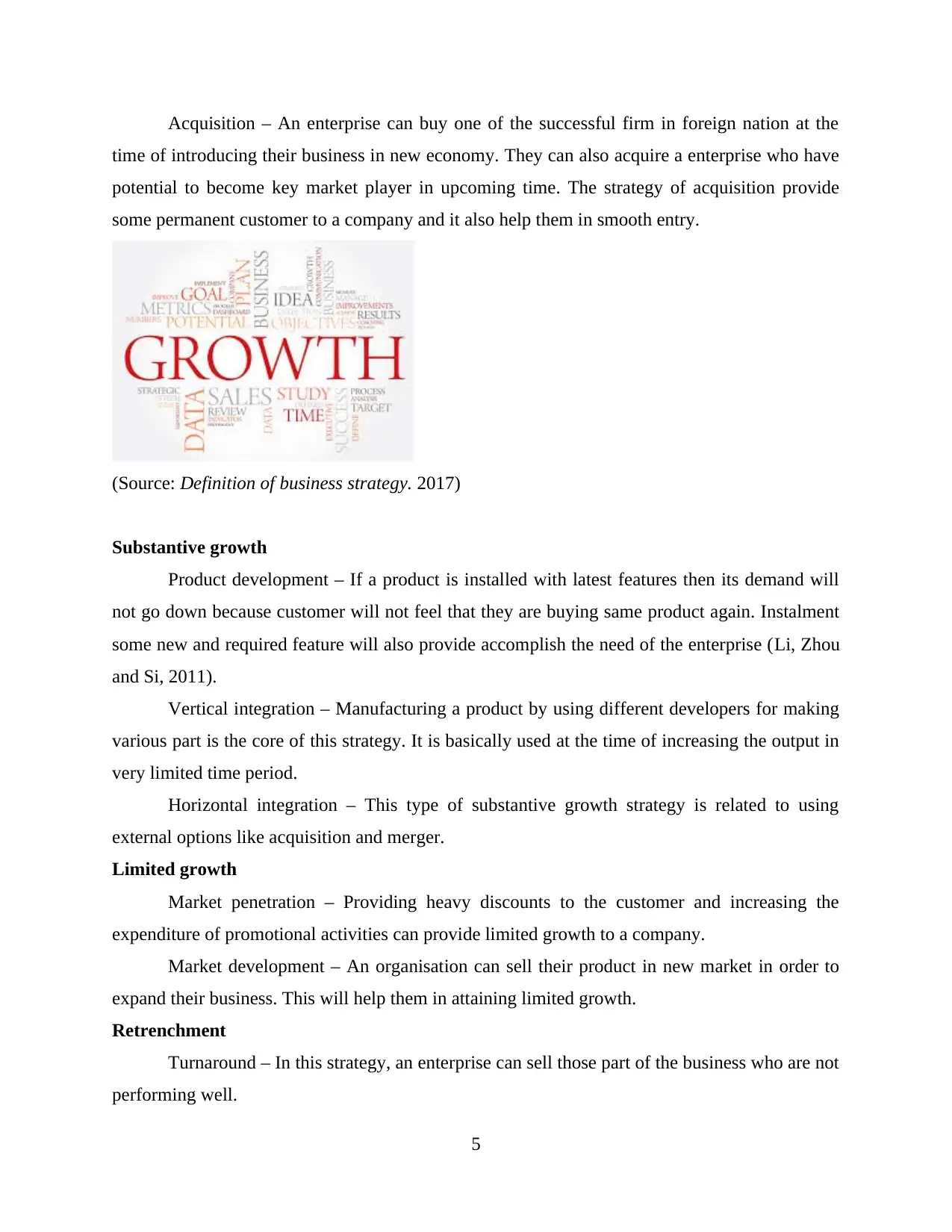
Acquisition – An enterprise can buy one of the successful firm in foreign nation at the
time of introducing their business in new economy. They can also acquire a enterprise who have
potential to become key market player in upcoming time. The strategy of acquisition provide
some permanent customer to a company and it also help them in smooth entry.
(Source: Definition of business strategy. 2017)
Substantive growth
Product development – If a product is installed with latest features then its demand will
not go down because customer will not feel that they are buying same product again. Instalment
some new and required feature will also provide accomplish the need of the enterprise (Li, Zhou
and Si, 2011).
Vertical integration – Manufacturing a product by using different developers for making
various part is the core of this strategy. It is basically used at the time of increasing the output in
very limited time period.
Horizontal integration – This type of substantive growth strategy is related to using
external options like acquisition and merger.
Limited growth
Market penetration – Providing heavy discounts to the customer and increasing the
expenditure of promotional activities can provide limited growth to a company.
Market development – An organisation can sell their product in new market in order to
expand their business. This will help them in attaining limited growth.
Retrenchment
Turnaround – In this strategy, an enterprise can sell those part of the business who are not
performing well.
5
time of introducing their business in new economy. They can also acquire a enterprise who have
potential to become key market player in upcoming time. The strategy of acquisition provide
some permanent customer to a company and it also help them in smooth entry.
(Source: Definition of business strategy. 2017)
Substantive growth
Product development – If a product is installed with latest features then its demand will
not go down because customer will not feel that they are buying same product again. Instalment
some new and required feature will also provide accomplish the need of the enterprise (Li, Zhou
and Si, 2011).
Vertical integration – Manufacturing a product by using different developers for making
various part is the core of this strategy. It is basically used at the time of increasing the output in
very limited time period.
Horizontal integration – This type of substantive growth strategy is related to using
external options like acquisition and merger.
Limited growth
Market penetration – Providing heavy discounts to the customer and increasing the
expenditure of promotional activities can provide limited growth to a company.
Market development – An organisation can sell their product in new market in order to
expand their business. This will help them in attaining limited growth.
Retrenchment
Turnaround – In this strategy, an enterprise can sell those part of the business who are not
performing well.
5
Paraphrase This Document
Need a fresh take? Get an instant paraphrase of this document with our AI Paraphraser
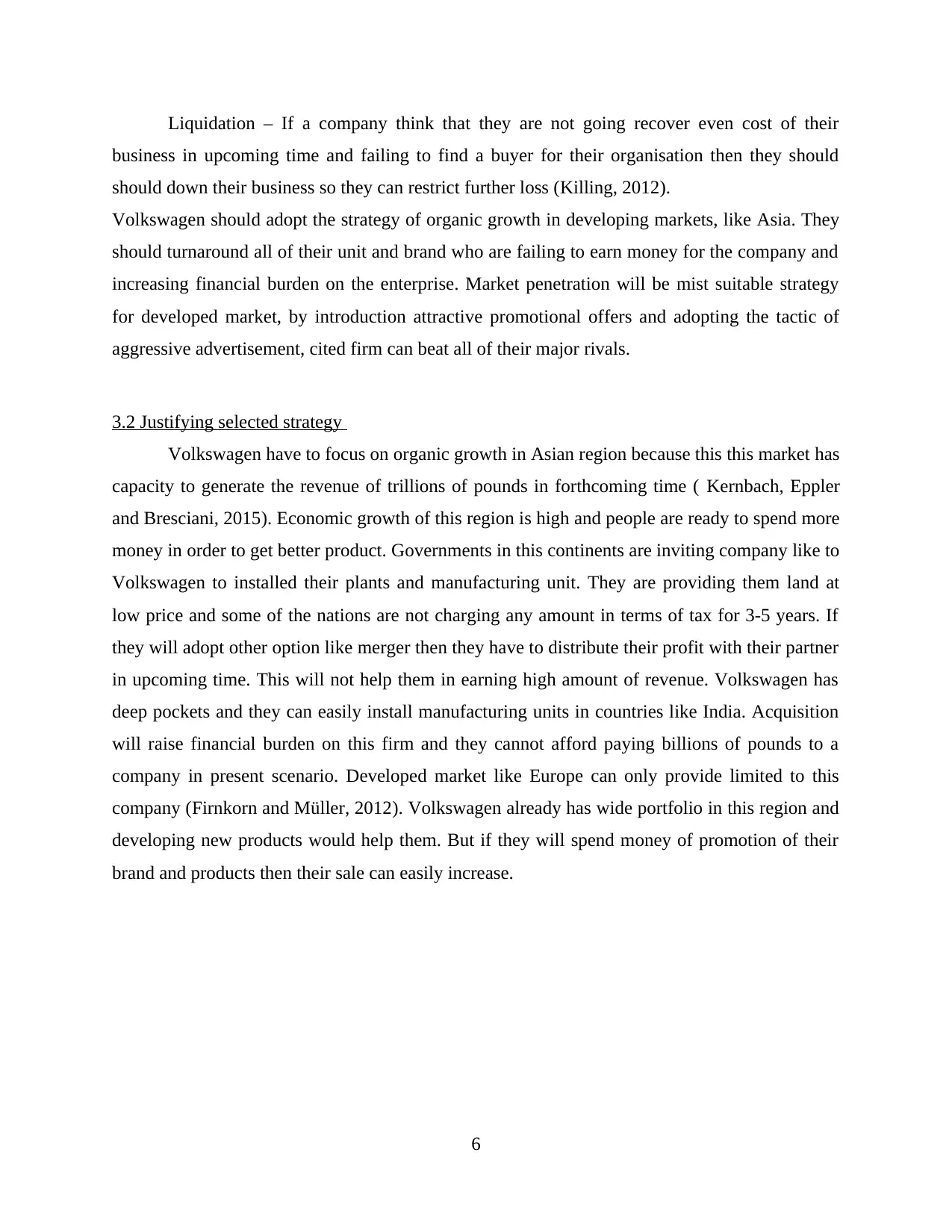
Liquidation – If a company think that they are not going recover even cost of their
business in upcoming time and failing to find a buyer for their organisation then they should
should down their business so they can restrict further loss (Killing, 2012).
Volkswagen should adopt the strategy of organic growth in developing markets, like Asia. They
should turnaround all of their unit and brand who are failing to earn money for the company and
increasing financial burden on the enterprise. Market penetration will be mist suitable strategy
for developed market, by introduction attractive promotional offers and adopting the tactic of
aggressive advertisement, cited firm can beat all of their major rivals.
3.2 Justifying selected strategy
Volkswagen have to focus on organic growth in Asian region because this this market has
capacity to generate the revenue of trillions of pounds in forthcoming time ( Kernbach, Eppler
and Bresciani, 2015). Economic growth of this region is high and people are ready to spend more
money in order to get better product. Governments in this continents are inviting company like to
Volkswagen to installed their plants and manufacturing unit. They are providing them land at
low price and some of the nations are not charging any amount in terms of tax for 3-5 years. If
they will adopt other option like merger then they have to distribute their profit with their partner
in upcoming time. This will not help them in earning high amount of revenue. Volkswagen has
deep pockets and they can easily install manufacturing units in countries like India. Acquisition
will raise financial burden on this firm and they cannot afford paying billions of pounds to a
company in present scenario. Developed market like Europe can only provide limited to this
company (Firnkorn and Müller, 2012). Volkswagen already has wide portfolio in this region and
developing new products would help them. But if they will spend money of promotion of their
brand and products then their sale can easily increase.
6
business in upcoming time and failing to find a buyer for their organisation then they should
should down their business so they can restrict further loss (Killing, 2012).
Volkswagen should adopt the strategy of organic growth in developing markets, like Asia. They
should turnaround all of their unit and brand who are failing to earn money for the company and
increasing financial burden on the enterprise. Market penetration will be mist suitable strategy
for developed market, by introduction attractive promotional offers and adopting the tactic of
aggressive advertisement, cited firm can beat all of their major rivals.
3.2 Justifying selected strategy
Volkswagen have to focus on organic growth in Asian region because this this market has
capacity to generate the revenue of trillions of pounds in forthcoming time ( Kernbach, Eppler
and Bresciani, 2015). Economic growth of this region is high and people are ready to spend more
money in order to get better product. Governments in this continents are inviting company like to
Volkswagen to installed their plants and manufacturing unit. They are providing them land at
low price and some of the nations are not charging any amount in terms of tax for 3-5 years. If
they will adopt other option like merger then they have to distribute their profit with their partner
in upcoming time. This will not help them in earning high amount of revenue. Volkswagen has
deep pockets and they can easily install manufacturing units in countries like India. Acquisition
will raise financial burden on this firm and they cannot afford paying billions of pounds to a
company in present scenario. Developed market like Europe can only provide limited to this
company (Firnkorn and Müller, 2012). Volkswagen already has wide portfolio in this region and
developing new products would help them. But if they will spend money of promotion of their
brand and products then their sale can easily increase.
6
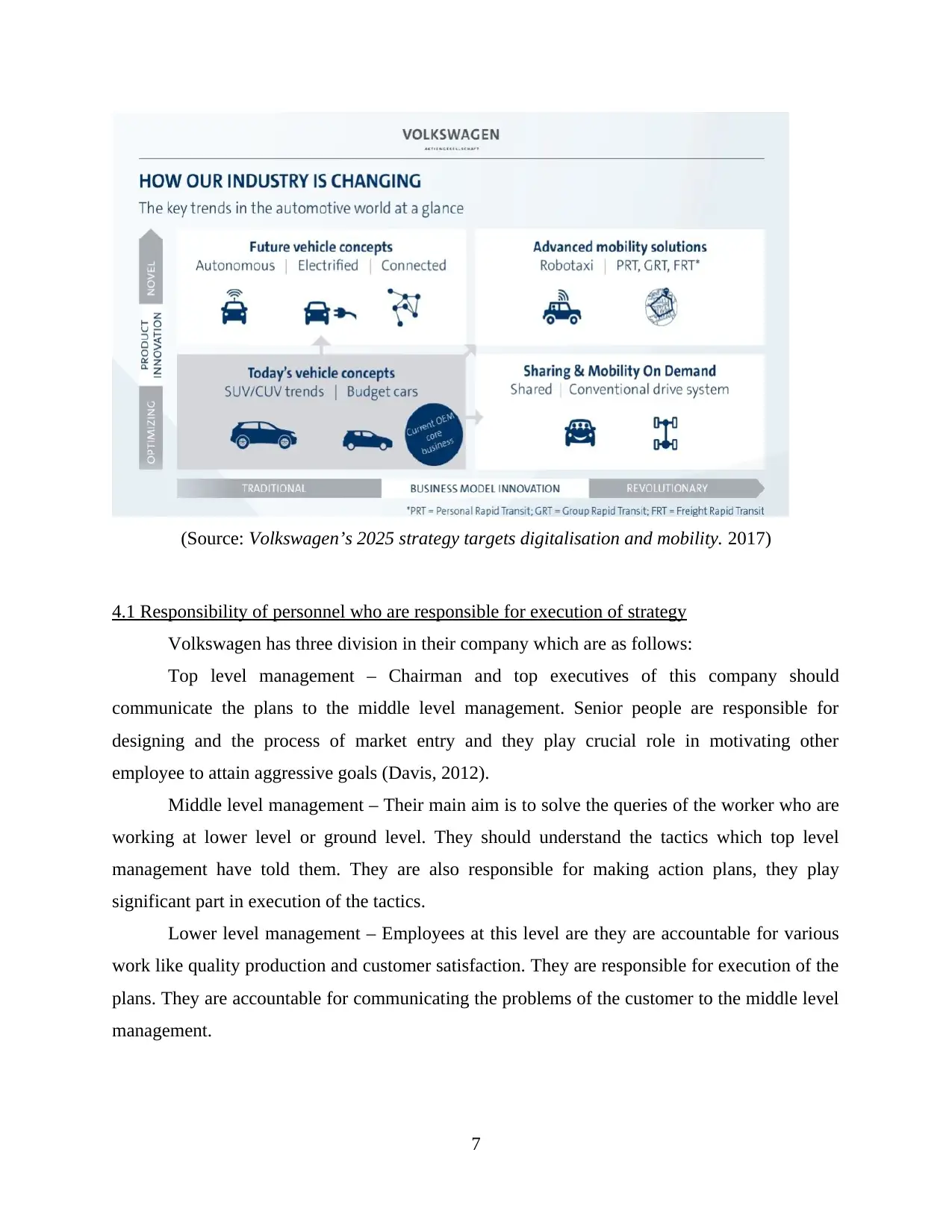
(Source: Volkswagen’s 2025 strategy targets digitalisation and mobility. 2017)
4.1 Responsibility of personnel who are responsible for execution of strategy
Volkswagen has three division in their company which are as follows:
Top level management – Chairman and top executives of this company should
communicate the plans to the middle level management. Senior people are responsible for
designing and the process of market entry and they play crucial role in motivating other
employee to attain aggressive goals (Davis, 2012).
Middle level management – Their main aim is to solve the queries of the worker who are
working at lower level or ground level. They should understand the tactics which top level
management have told them. They are also responsible for making action plans, they play
significant part in execution of the tactics.
Lower level management – Employees at this level are they are accountable for various
work like quality production and customer satisfaction. They are responsible for execution of the
plans. They are accountable for communicating the problems of the customer to the middle level
management.
7
4.1 Responsibility of personnel who are responsible for execution of strategy
Volkswagen has three division in their company which are as follows:
Top level management – Chairman and top executives of this company should
communicate the plans to the middle level management. Senior people are responsible for
designing and the process of market entry and they play crucial role in motivating other
employee to attain aggressive goals (Davis, 2012).
Middle level management – Their main aim is to solve the queries of the worker who are
working at lower level or ground level. They should understand the tactics which top level
management have told them. They are also responsible for making action plans, they play
significant part in execution of the tactics.
Lower level management – Employees at this level are they are accountable for various
work like quality production and customer satisfaction. They are responsible for execution of the
plans. They are accountable for communicating the problems of the customer to the middle level
management.
7
⊘ This is a preview!⊘
Do you want full access?
Subscribe today to unlock all pages.

Trusted by 1+ million students worldwide
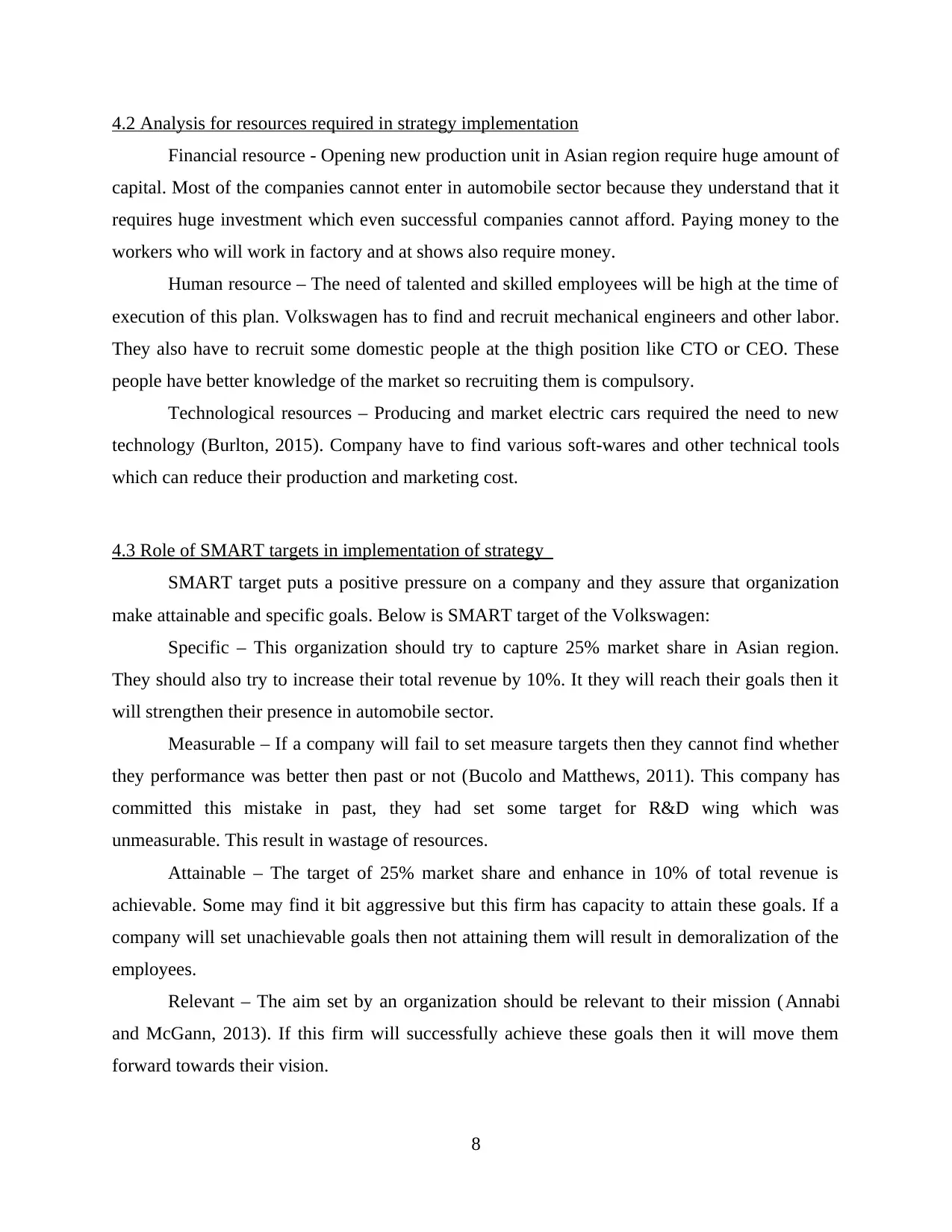
4.2 Analysis for resources required in strategy implementation
Financial resource - Opening new production unit in Asian region require huge amount of
capital. Most of the companies cannot enter in automobile sector because they understand that it
requires huge investment which even successful companies cannot afford. Paying money to the
workers who will work in factory and at shows also require money.
Human resource – The need of talented and skilled employees will be high at the time of
execution of this plan. Volkswagen has to find and recruit mechanical engineers and other labor.
They also have to recruit some domestic people at the thigh position like CTO or CEO. These
people have better knowledge of the market so recruiting them is compulsory.
Technological resources – Producing and market electric cars required the need to new
technology (Burlton, 2015). Company have to find various soft-wares and other technical tools
which can reduce their production and marketing cost.
4.3 Role of SMART targets in implementation of strategy
SMART target puts a positive pressure on a company and they assure that organization
make attainable and specific goals. Below is SMART target of the Volkswagen:
Specific – This organization should try to capture 25% market share in Asian region.
They should also try to increase their total revenue by 10%. It they will reach their goals then it
will strengthen their presence in automobile sector.
Measurable – If a company will fail to set measure targets then they cannot find whether
they performance was better then past or not (Bucolo and Matthews, 2011). This company has
committed this mistake in past, they had set some target for R&D wing which was
unmeasurable. This result in wastage of resources.
Attainable – The target of 25% market share and enhance in 10% of total revenue is
achievable. Some may find it bit aggressive but this firm has capacity to attain these goals. If a
company will set unachievable goals then not attaining them will result in demoralization of the
employees.
Relevant – The aim set by an organization should be relevant to their mission (Annabi
and McGann, 2013). If this firm will successfully achieve these goals then it will move them
forward towards their vision.
8
Financial resource - Opening new production unit in Asian region require huge amount of
capital. Most of the companies cannot enter in automobile sector because they understand that it
requires huge investment which even successful companies cannot afford. Paying money to the
workers who will work in factory and at shows also require money.
Human resource – The need of talented and skilled employees will be high at the time of
execution of this plan. Volkswagen has to find and recruit mechanical engineers and other labor.
They also have to recruit some domestic people at the thigh position like CTO or CEO. These
people have better knowledge of the market so recruiting them is compulsory.
Technological resources – Producing and market electric cars required the need to new
technology (Burlton, 2015). Company have to find various soft-wares and other technical tools
which can reduce their production and marketing cost.
4.3 Role of SMART targets in implementation of strategy
SMART target puts a positive pressure on a company and they assure that organization
make attainable and specific goals. Below is SMART target of the Volkswagen:
Specific – This organization should try to capture 25% market share in Asian region.
They should also try to increase their total revenue by 10%. It they will reach their goals then it
will strengthen their presence in automobile sector.
Measurable – If a company will fail to set measure targets then they cannot find whether
they performance was better then past or not (Bucolo and Matthews, 2011). This company has
committed this mistake in past, they had set some target for R&D wing which was
unmeasurable. This result in wastage of resources.
Attainable – The target of 25% market share and enhance in 10% of total revenue is
achievable. Some may find it bit aggressive but this firm has capacity to attain these goals. If a
company will set unachievable goals then not attaining them will result in demoralization of the
employees.
Relevant – The aim set by an organization should be relevant to their mission (Annabi
and McGann, 2013). If this firm will successfully achieve these goals then it will move them
forward towards their vision.
8
Paraphrase This Document
Need a fresh take? Get an instant paraphrase of this document with our AI Paraphraser
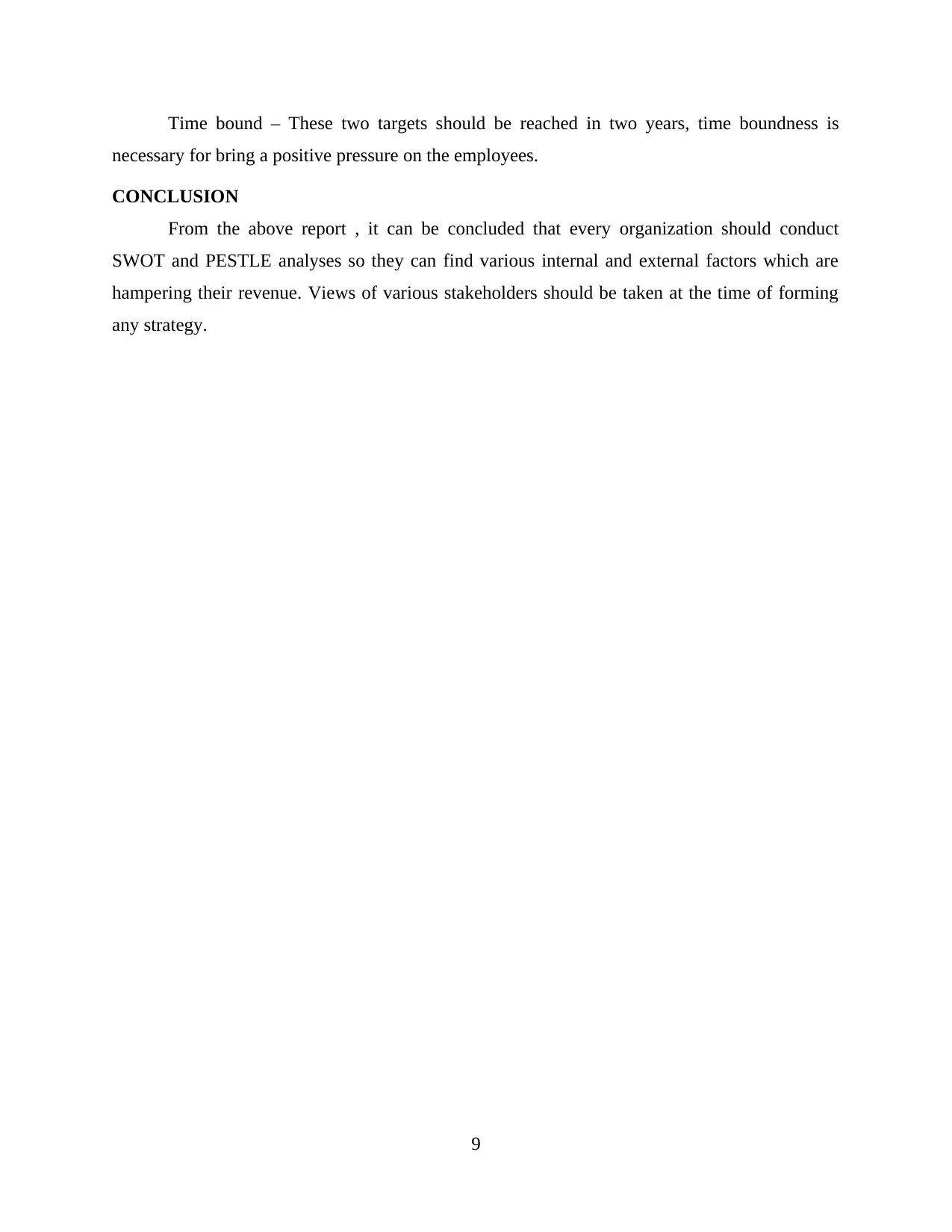
Time bound – These two targets should be reached in two years, time boundness is
necessary for bring a positive pressure on the employees.
CONCLUSION
From the above report , it can be concluded that every organization should conduct
SWOT and PESTLE analyses so they can find various internal and external factors which are
hampering their revenue. Views of various stakeholders should be taken at the time of forming
any strategy.
9
necessary for bring a positive pressure on the employees.
CONCLUSION
From the above report , it can be concluded that every organization should conduct
SWOT and PESTLE analyses so they can find various internal and external factors which are
hampering their revenue. Views of various stakeholders should be taken at the time of forming
any strategy.
9
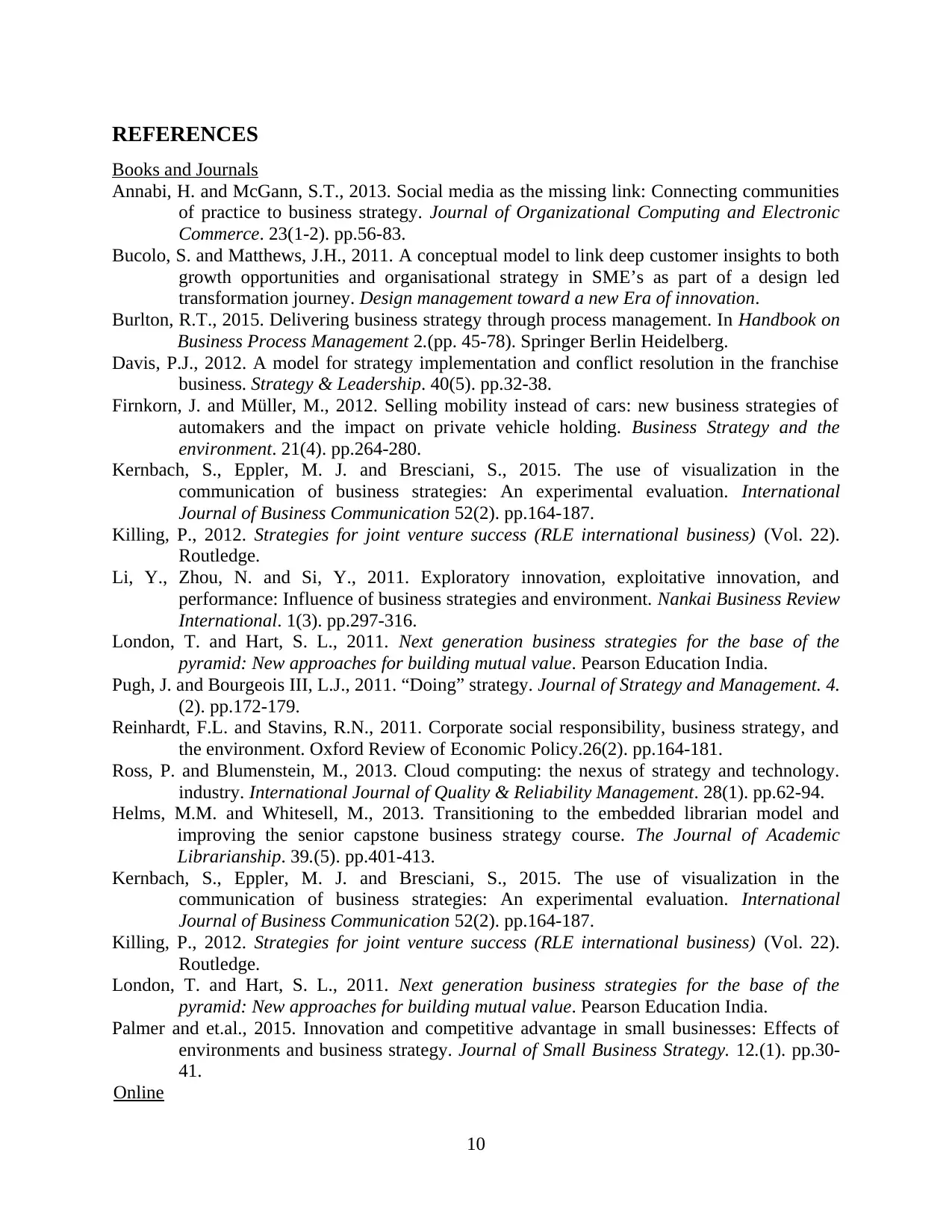
REFERENCES
Books and Journals
Annabi, H. and McGann, S.T., 2013. Social media as the missing link: Connecting communities
of practice to business strategy. Journal of Organizational Computing and Electronic
Commerce. 23(1-2). pp.56-83.
Bucolo, S. and Matthews, J.H., 2011. A conceptual model to link deep customer insights to both
growth opportunities and organisational strategy in SME’s as part of a design led
transformation journey. Design management toward a new Era of innovation.
Burlton, R.T., 2015. Delivering business strategy through process management. In Handbook on
Business Process Management 2.(pp. 45-78). Springer Berlin Heidelberg.
Davis, P.J., 2012. A model for strategy implementation and conflict resolution in the franchise
business. Strategy & Leadership. 40(5). pp.32-38.
Firnkorn, J. and Müller, M., 2012. Selling mobility instead of cars: new business strategies of
automakers and the impact on private vehicle holding. Business Strategy and the
environment. 21(4). pp.264-280.
Kernbach, S., Eppler, M. J. and Bresciani, S., 2015. The use of visualization in the
communication of business strategies: An experimental evaluation. International
Journal of Business Communication 52(2). pp.164-187.
Killing, P., 2012. Strategies for joint venture success (RLE international business) (Vol. 22).
Routledge.
Li, Y., Zhou, N. and Si, Y., 2011. Exploratory innovation, exploitative innovation, and
performance: Influence of business strategies and environment. Nankai Business Review
International. 1(3). pp.297-316.
London, T. and Hart, S. L., 2011. Next generation business strategies for the base of the
pyramid: New approaches for building mutual value. Pearson Education India.
Pugh, J. and Bourgeois III, L.J., 2011. “Doing” strategy. Journal of Strategy and Management. 4.
(2). pp.172-179.
Reinhardt, F.L. and Stavins, R.N., 2011. Corporate social responsibility, business strategy, and
the environment. Oxford Review of Economic Policy.26(2). pp.164-181.
Ross, P. and Blumenstein, M., 2013. Cloud computing: the nexus of strategy and technology.
industry. International Journal of Quality & Reliability Management. 28(1). pp.62-94.
Helms, M.M. and Whitesell, M., 2013. Transitioning to the embedded librarian model and
improving the senior capstone business strategy course. The Journal of Academic
Librarianship. 39.(5). pp.401-413.
Kernbach, S., Eppler, M. J. and Bresciani, S., 2015. The use of visualization in the
communication of business strategies: An experimental evaluation. International
Journal of Business Communication 52(2). pp.164-187.
Killing, P., 2012. Strategies for joint venture success (RLE international business) (Vol. 22).
Routledge.
London, T. and Hart, S. L., 2011. Next generation business strategies for the base of the
pyramid: New approaches for building mutual value. Pearson Education India.
Palmer and et.al., 2015. Innovation and competitive advantage in small businesses: Effects of
environments and business strategy. Journal of Small Business Strategy. 12.(1). pp.30-
41.
Online
10
Books and Journals
Annabi, H. and McGann, S.T., 2013. Social media as the missing link: Connecting communities
of practice to business strategy. Journal of Organizational Computing and Electronic
Commerce. 23(1-2). pp.56-83.
Bucolo, S. and Matthews, J.H., 2011. A conceptual model to link deep customer insights to both
growth opportunities and organisational strategy in SME’s as part of a design led
transformation journey. Design management toward a new Era of innovation.
Burlton, R.T., 2015. Delivering business strategy through process management. In Handbook on
Business Process Management 2.(pp. 45-78). Springer Berlin Heidelberg.
Davis, P.J., 2012. A model for strategy implementation and conflict resolution in the franchise
business. Strategy & Leadership. 40(5). pp.32-38.
Firnkorn, J. and Müller, M., 2012. Selling mobility instead of cars: new business strategies of
automakers and the impact on private vehicle holding. Business Strategy and the
environment. 21(4). pp.264-280.
Kernbach, S., Eppler, M. J. and Bresciani, S., 2015. The use of visualization in the
communication of business strategies: An experimental evaluation. International
Journal of Business Communication 52(2). pp.164-187.
Killing, P., 2012. Strategies for joint venture success (RLE international business) (Vol. 22).
Routledge.
Li, Y., Zhou, N. and Si, Y., 2011. Exploratory innovation, exploitative innovation, and
performance: Influence of business strategies and environment. Nankai Business Review
International. 1(3). pp.297-316.
London, T. and Hart, S. L., 2011. Next generation business strategies for the base of the
pyramid: New approaches for building mutual value. Pearson Education India.
Pugh, J. and Bourgeois III, L.J., 2011. “Doing” strategy. Journal of Strategy and Management. 4.
(2). pp.172-179.
Reinhardt, F.L. and Stavins, R.N., 2011. Corporate social responsibility, business strategy, and
the environment. Oxford Review of Economic Policy.26(2). pp.164-181.
Ross, P. and Blumenstein, M., 2013. Cloud computing: the nexus of strategy and technology.
industry. International Journal of Quality & Reliability Management. 28(1). pp.62-94.
Helms, M.M. and Whitesell, M., 2013. Transitioning to the embedded librarian model and
improving the senior capstone business strategy course. The Journal of Academic
Librarianship. 39.(5). pp.401-413.
Kernbach, S., Eppler, M. J. and Bresciani, S., 2015. The use of visualization in the
communication of business strategies: An experimental evaluation. International
Journal of Business Communication 52(2). pp.164-187.
Killing, P., 2012. Strategies for joint venture success (RLE international business) (Vol. 22).
Routledge.
London, T. and Hart, S. L., 2011. Next generation business strategies for the base of the
pyramid: New approaches for building mutual value. Pearson Education India.
Palmer and et.al., 2015. Innovation and competitive advantage in small businesses: Effects of
environments and business strategy. Journal of Small Business Strategy. 12.(1). pp.30-
41.
Online
10
⊘ This is a preview!⊘
Do you want full access?
Subscribe today to unlock all pages.

Trusted by 1+ million students worldwide
1 out of 13
Related Documents
Your All-in-One AI-Powered Toolkit for Academic Success.
+13062052269
info@desklib.com
Available 24*7 on WhatsApp / Email
![[object Object]](/_next/static/media/star-bottom.7253800d.svg)
Unlock your academic potential
Copyright © 2020–2025 A2Z Services. All Rights Reserved. Developed and managed by ZUCOL.





